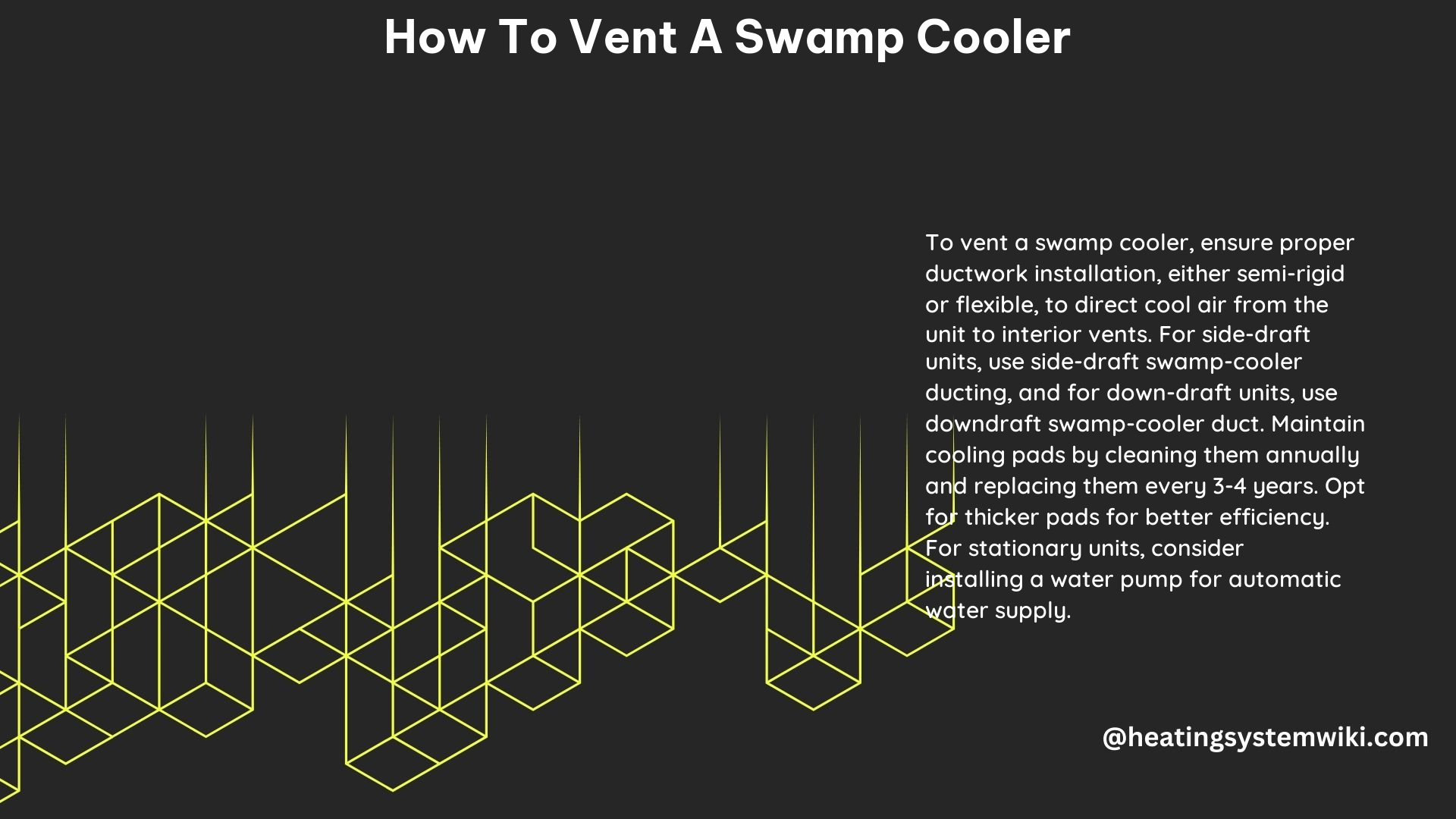Swamp coolers, also known as evaporative coolers, are a popular and energy-efficient way to cool your home, especially in dry climates. Proper venting is crucial for the efficient operation of a swamp cooler, as it ensures the hot air has a path to exit and allows the cool air to circulate effectively. In this comprehensive guide, we’ll dive deep into the technical details of how to vent a swamp cooler and provide you with a step-by-step playbook to ensure your cooling system runs at its best.
Understanding the Swamp Cooler Venting Process
Swamp coolers work by drawing in hot, dry air from the outside and passing it over water-soaked pads. As the air passes through the pads, the water evaporates, cooling the air. This cooled air is then circulated throughout the building. However, for this process to work effectively, the hot air that has been cooled must have a way to exit the building, allowing the cooler air to enter and circulate.
The venting process is essential for maintaining the desired humidity level and preventing the buildup of hot air within the space. Proper venting ensures that the swamp cooler can operate at its maximum efficiency, providing the most effective cooling for your home or office.
Calculating the Optimal Vent Size

The size of the vent or window opening required for your swamp cooler depends on the unit’s CFM (Cubic Feet per Minute) rating. This rating indicates the volume of air the cooler can move in a minute.
To calculate the optimal vent size, follow these steps:
- Measure the square footage of the space you want to cool.
- Multiply the square footage by the ceiling height to get the total volume of the space.
- Divide the total volume by 2 to determine the required CFM for the space.
- Refer to the CFM rating of your swamp cooler and ensure the vent or window opening is at least that size.
As a general rule, you should open windows or vents about 2 to 4 inches to allow the hot air to escape and the cool air to circulate effectively.
Factors to Consider When Venting a Swamp Cooler
When venting a swamp cooler, there are several factors to consider to ensure optimal performance:
-
Dew Point: The dew point is the temperature at which the water in the air begins to condense. A lower dew point allows for more effective cooling, as the air can hold more moisture before reaching saturation. Monitor the dew point and adjust the vent size accordingly.
-
Humidity Levels: Swamp coolers work best in dry climates, as they rely on the evaporation of water to cool the air. In humid environments, the cooling efficiency may be reduced, and you may need to adjust the vent size to maintain the desired humidity level.
-
Air Circulation: Ensure that the cooled air from the swamp cooler can circulate throughout the space effectively. This may require strategically placed fans or additional vents to promote air movement.
-
Insulation and Sealing: Proper insulation and sealing of the building can help maintain the desired temperature and humidity levels, reducing the strain on the swamp cooler and improving its efficiency.
-
Maintenance: Regular maintenance, such as cleaning the water pads and checking for any leaks or blockages, is essential for the optimal performance of your swamp cooler.
Swamp Cooler Vent Configurations
Swamp coolers come in various configurations, each with its own venting requirements. Let’s explore the most common types and their venting needs:
Window-Mounted Swamp Coolers
Window-mounted swamp coolers are installed directly in a window opening. For these units, the vent or window opening should be at least the same size as the cooler’s air intake and exhaust openings, typically around 12 to 24 inches wide.
Roof-Mounted Swamp Coolers
Roof-mounted swamp coolers are installed on the roof of the building. These units require a dedicated vent or opening in the ceiling or roof to allow the hot air to escape. The size of the vent should be based on the cooler’s CFM rating, as mentioned earlier.
Ground-Mounted Swamp Coolers
Ground-mounted swamp coolers are installed on the ground, typically near a window or wall. These units may require a dedicated vent or ductwork to channel the hot air outside, with the vent size determined by the cooler’s CFM rating.
Troubleshooting Swamp Cooler Venting Issues
If you’re experiencing issues with your swamp cooler’s performance, such as poor cooling or high humidity levels, it’s essential to check the venting system. Here are some common problems and their solutions:
-
Insufficient Vent Size: If the vent or window opening is too small, it can restrict the airflow, leading to poor cooling and high humidity. Increase the vent size to match the cooler’s CFM rating.
-
Blocked or Obstructed Vents: Ensure that the vents or windows are not blocked by furniture, curtains, or other objects, as this can impede the airflow.
-
Improper Vent Placement: The vent or window should be located in a way that allows the hot air to easily escape, and the cool air to circulate throughout the space. Experiment with different vent locations to find the optimal setup.
-
Excessive Humidity: If the humidity levels remain high, even with the vents open, you may need to adjust the vent size or consider using a dehumidifier in conjunction with the swamp cooler.
-
Leaks or Damage: Check the swamp cooler and the venting system for any leaks or damage that could be affecting the airflow and cooling efficiency.
By understanding the technical details and following the best practices for venting a swamp cooler, you can ensure your cooling system operates at its peak performance, providing you with a comfortable and energy-efficient indoor environment.
